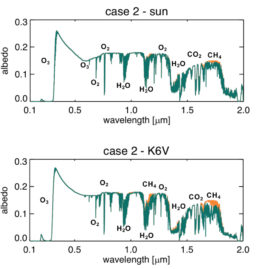Signs of life in planetary atmospheres are hard to spot! A new study suggests that the best strategy for discovering them may be to look at planets orbiting K-dwarf stars.
The Hunt for Fingerprints
Is there life beyond Earth? This remains one of the most profound scientific questions astronomers are currently poised to address, and development of ever more powerful telescopes continues to bring us closer to an answer.
One way we can hope to use these telescopes to identify the presence of life on distant exoplanets is by detecting atmospheric biosignatures. Left alone, a planet’s atmosphere ought to be in chemical equilibrium. But when life is present, the atmosphere accumulates excess gases produced by the life — telltale fingerprints that we can hope to spot.
Signatures in Methane

The spectra of various types of stars used by the author in models, including the Sun (a G2V dwarf) and three types of K dwarfs. K dwarfs produce less radiation in the 200–350 nm range. [Adapted from Arney 2019]
There’s hope, though: some planets may be more likely to maintain life-produced methane in their atmospheres than others. Stellar light in the 200–350 nm range triggers this reaction — so the less light a planet’s host star produces in this range, the longer methane can survive in the planet’s atmosphere. This means that the type of host star matters: G dwarfs like the Sun will destroy the methane in their planets’ atmospheres faster than smaller and cooler M dwarfs.

Spectra from two of the author’s modeled quasi-modern planets: one around the Sun, and one around a K6V star. Orange lines show the spectra with methane removed, making the methane absorption features easier to see. The absorption features are much more evident in the planet around the K dwarf. [Adapted from Arney 2019]
The K-Dwarf Advantage
K dwarfs fall between G and M dwarfs in size and temperature, and they are more abundant than G dwarfs. Dimmer than G dwarfs, K dwarfs provide better planet-to-star contrast ratios that make it easier to observe potential habitable worlds. And they are are less active than M dwarfs, providing a more hospitable environment for their planets.
In addition to these benefits, K dwarfs also produce less radiation in the 200–350 nm range than G dwarfs do. By using a one-dimensional photochemical climate model to simulate a variety of planetary atmospheres, Arney demonstrates that a planet orbiting a K6V star can support roughly an order of magnitude more methane in the presence of oxygen relative to an equivalent planet around a G2V dwarf like the Sun.

Artist’s impression for one possible configuration of the proposed HabEx mission, in which a starshade could be used to help better image distant exoplanets. [NASA/JPL/Caltech]
Citation
“The K Dwarf Advantage for Biosignatures on Directly Imaged Exoplanets,” Giada N. Arney 2019 ApJL 873 L7. doi:10.3847/2041-8213/ab0651

2 Comments
Pingback: ONDE DEVEMOS PROCURAR POR VIDA NO UNIVERSO? | SPACE TODAY TV EP.1756 - MDSH
Pingback: ONDE DEVEMOS PROCURAR POR VIDA NO UNIVERSO? | SPACE TODAY TV EP.1756 | Mestre Jedi